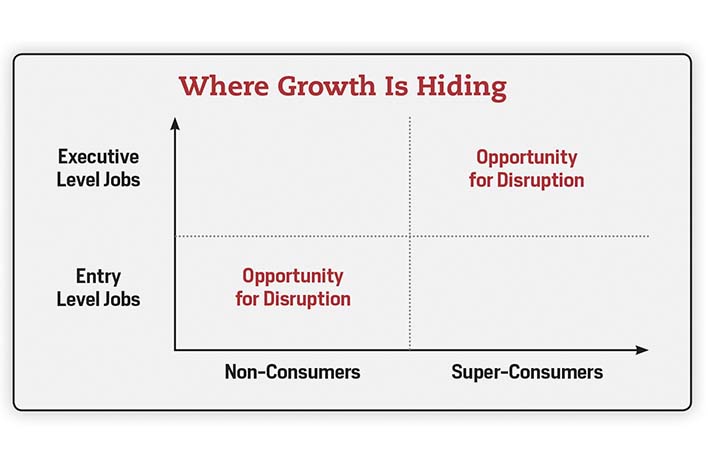How to find new opportunities in often-overlooked areas of the market.
After years of researching and advising clients around the world on innovation and growth strategy, we have observed that:
- Nearly everyone wants innovation and growth.
- There is consensus that the very best way to innovate and to grow is to “make the pie bigger”—that is, to grow categories and expand markets—instinctively recognizing that carving incremental market share out of the hide of your competition is a messy business.
- Surprisingly few companies systematically pursue true pie-growing strategies. In general, we find clients engaging across a range of activities—some fruitful, some less so—to drive desired growth, which we’ve summarized here.
With a solid existing product in hand, most clients begin by transitioning further and further upmarket, striving (and often realizing) incremental pricing power and margin realization.
This works for a while, until further growth is sought, and then clients often turn to increased specialization at the premium end. Eventually, there is a proliferation of customized and specialized products to address profitable niche markets and extract further value from the market.
When that strategy begins to lose steam, clients turn to the lower end of the market, and work feverishly to make lemonade from lemons. The lemonade in these situations will often take two forms, either the development of new business models designed to enable profit realization at the lower end of the market or mechanisms to fundamentally unlock nonconsumption.
And when those approaches collectively fail to drive further incremental growth, one is flummoxed.
We’d argue that it’s not that growth potential is not there, it’s just hiding where businesses aren’t used to looking.
Superconsumers and Jobs Theory
Let’s introduce two concepts that are help-ful in surfacing these opportunities from the often-overlooked areas of the market.
Concept 1: Superconsumers // Who are they? They are the high-passion, high-profit consumers found in every category. They spend three to seven times more than the average person in a category. They are knowledgeable about the category and passionate, are willing to pay a higher price per unit and enthusiastically share their expertise and knowledge with others.
Concept 2: Jobs Theory // This represents a fundamental shift in our thinking. Consumers do not buy brands and products. Instead, they hire them to create desired experiences and make progress in their lives. Successful innovations fundamentally identify people with important jobs to be done that have only incomplete or inadequate solutions—and then deliver solutions that enable the desired progress that people seek.
Some jobs are “executive level” jobs meeting rational, emotional and social benefits, and others are more “entry level” jobs, addressing primarily rational benefits. The most successful innovations are fueled by converting nonconsumers into consumers and intermittent customers into regular, profitable ones.
What happens when one overlays these concepts? New growth opportunities are brought to the surface. Traditional approaches and frameworks consistently highlight the intersection of Superconsumers and executive-level jobs as the key area for margin growth, and just as many highlight opportunities to convert nonconsumers into consumers via successful delivery of entry-level jobs, often by category disruptors.
Very few, however, surface the remaining two quadrants: entry-level jobs for Super-consumers and executive-level jobs for nonconsumers. Companies overlook those opportunities at their own peril.
How Keurig Found Hidden Markets
Think about Keurig. If you try to imagine their ideal customer, one often immediately pictures consumers who love coffee and spend more than $600 per year on it. That focus is intuitive, and clearly benefits margin potential. But that’s not really the Keurig story. Instead, Keurig successfully performs an executive-level job for nonconsumers and an entry-level job for Superconsumers.
Consider the following. Someone who doesn’t really buy coffee (a nonconsumer) is planning a splendid dinner party with a coffee course, but possesses little to no knowledge of how to deliver it. Enter Keurig. It makes a great cup of coffee that is completely customizable, a perfect finish to a meal and a reaffirmation of one’s exceptional hosting skills. That’s an executive-level job for a nonconsumer, satisfied by Keurig.
For the coffee Superconsumer, Keurig is asked to do something decidedly different. For a true coffee Super-consumer, Keurig does not deliver an executive-level “craft coffee” experience, but rather an entry-level quick cup of coffee on a schedule.
Such market opportunities are hidden in plain sight all around you. They are terribly difficult to spot, however, until viewed through the Superconsumer and Jobs Theory lenses. Only with this understanding can one truly see the “jobs” for which consumers are hiring, and the progress they are seeking to make in their lives.
Only with that understanding can innovators meet consumers where they are, with solutions people will predictably buy, use and celebrate.


